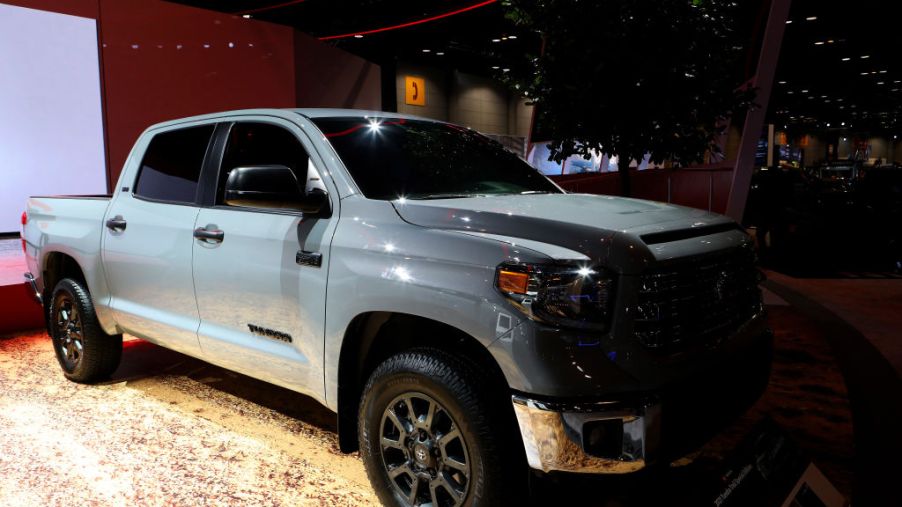
The 2020 Toyota Tundra’s Standard V8 Engine Is Its ‘Best Attribute’
The Toyota Tundra was introduced in 2000, becoming the first full-size pickup truck from a Japanese auto manufacturer sold in North America. The 2020 Tundra is part of a generation that has been around since 2007, updated only slightly in 2014, which gives it a dated feel.
The current generation is also much larger than the past ones. The change was meant to help the Tundra compete with other full-size pickup trucks, but instead cost the Tundra the “refinement” it offered in past generations, according to Consumer Reports. However, the 2020 Tundra’s standard V8 engine continues to be its best attribute.
The 2020 Toyota Tundra
In its review of the 2020 Toyota Tundra, Consumer Reports isn’t very positive about the truck. It doesn’t have as smooth a ride as its competitors, especially with the TRD package meant for off-road driving, and isn’t as easy to drive either.
The interior has plenty of space and lots of legroom in the rear seats. However, Car and Driver felt the design is outdated and the materials not luxurious enough.
On the plus side, the truck has a hydraulically damped tailgate, which makes it easy to open and close. It is also the most reliable full-size truck available. The infotainment system on most trim levels is compatible with Apple CarPlay and Android Auto.
Praise for the V8 engine
Consumer Reports points to the Toyota Tundra’s engine as the truck’s best attribute. The 2020 Tundra has a 5.7-liter V8, producing 381 hp and 401 lb-ft of torque. It’s paired with a six-speed transmission. The Tundra is able to go from zero to 60 MPG in 6.7 seconds, which makes it one of the fastest full-size trucks.
It has excellent towing and off-road capabilities and is available with either two-wheel drive or four-wheel drive. The Tundra comes standard with its tow/haul transmission modes plus a hitch and trailer wiring, all features that are optional on many other trucks. It can tow up to 10,200 pounds.
The two-wheel-drive Tundra is rated for a fuel efficiency of 13 MPG in the city and 18 MPG on the highway, for 15 MPG combined. Consumer Reports calls that rating “still competitive,” but Car and Driver points out it’s the worst in its class.
With such a powerful engine, Consumer Reports notes that the rear wheels do easily spin. In past years, the Tundra had a second V8 option, the 4.6-liter V8, which was standard. Now all trims have the 5.7-liter V8 engine.
Other full-size trucks’ engines
Many other full-size pickup trucks offer a V6 engine, but, even with the improvements to today’s V6 engines and their better fuel efficiency, buyers look for the power that comes from V8 engines.
According to WardsAuto, 80.8% of 2019 Ford F-150s were assembled with one of four V6 engines. For the Ram 1500, 8.3% of 2019 Ram 1500s had a V6, and 35.2% of 2019 Ram Classics did too. General Motors produced 15.5% of Chevrolet Silverados and 2.8% of GMC Sierras with V6 engines.
In addition to four V6 engines, the 2020 F-150 has a diesel option and its V8 option, a 5.0-liter engine generating 395 hp and 400 lb-ft of torque. The 2020 Ram 1500 offers a diesel engine, a V6 engine, and a 5.7-liter V8 with or without a mild hybrid system. The V8 produces 395 hp and 410 lb-ft of torque.
Along with inline-four, diesel, and V6 engines, the 2020 Chevrolet Silverado and GMC Sierra trucks have two V8 engines: a 5.3-liter V-8, generating 355 hp and 383 lb-ft of torque, along with the 6.2-liter V-8, producing 420 hp and 460 lb-ft of torque.
The Performance Upgrade package increases that to 435 hp and 469 lb-ft of torque. Like the Toyota Tundra, the 2020 Nissan Titan also does not offer a V6. Instead, it has a 5.6-liter V8, producing 400 hp and 413 lb-ft of torque.
The Toyota Tundra last had a V6 engine option with the 2014 model year; however, there is a possibility, according to WardsAuto, that a V6 may return for 2021. For 2020, the Tundra’s standard V8 engine offers power for off-road drivers.


